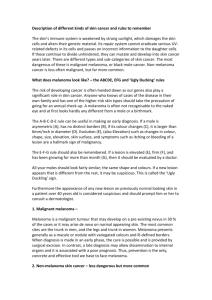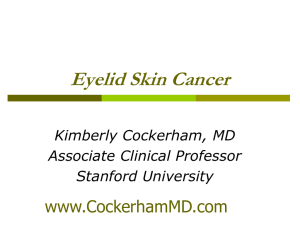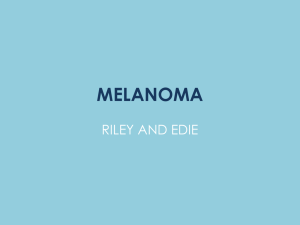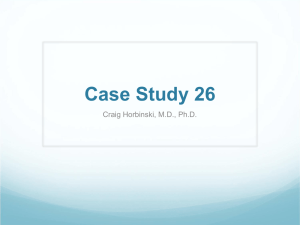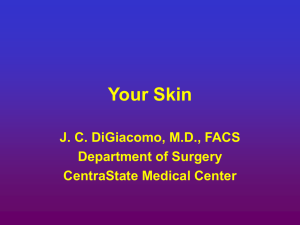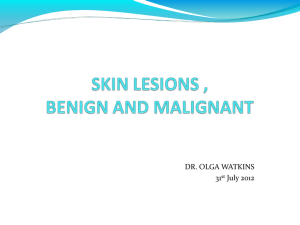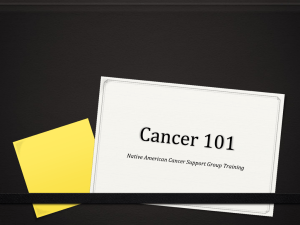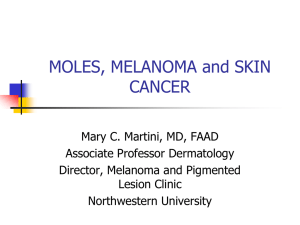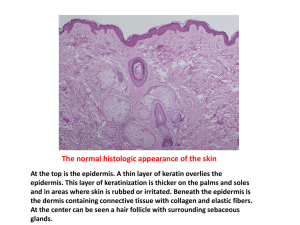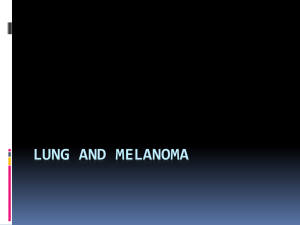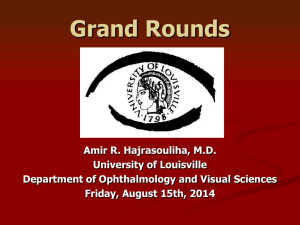Skin Cancer - Airedale Gp Training
advertisement
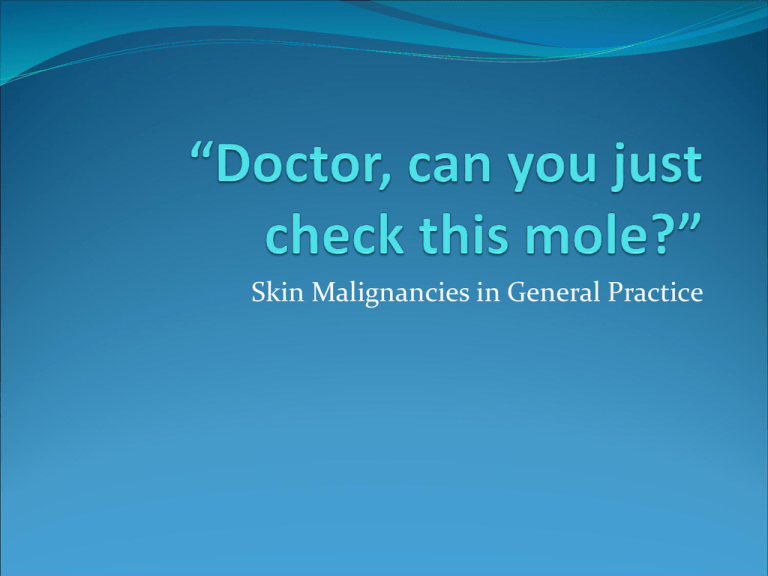
Skin Malignancies in General Practice The Anatomy of Skin Melanoma vs Non-Melanoma MELANOMA NON-MELANOMA Superficial Spreading SCC Nodular BCC Lentigo Others Acral Melanoma Melanoma - Epidemiology Incidence tenfold in past 70 years Queensland, New Zealand, South Africa. Female > Male Higher income, & higher education Melanoma - Aetiology Sun Exposure Melanoma - Aetiology Skin Type Melanoma - Aetiology Intermittent sun-burn Melanoma – Clinical Features Try and avoid spot diagnosis Melanoma – Clinical Features MAJOR Change in Size Change in Shape > 95% of presentations Change in Colour But not specific. Many moles change slowly over time. Melanoma – Clinical Features MINOR Diameter ≥ 7mm Itching or bleeding Crusting or oozing < 50% of presentations Inflammation But these are signs that patients are most concerned about. American Cancer Society A – Asymmetry B – Border Irregularity C – Colour Irregularity D – Diameter > 6mm E – Elevation / Evolution Key Feature An irregular edge is the single most important clinical feature. Superficial Spreading Melanoma 70% of all melanomas Younger age group Will eventually become nodular Normal skin or pre-existing mole Nodular melanoma (EFG) Elevated, Firm, Growing (usually all three) 20% of melanomas Older age group Usually darker (may be amelanocytic) Lentigo Malignant Melanoma > 60 yrs old Sun-damaged skin (usually the face) Pre-malignant horizontal growth phase (Hutchinson’s melanotic freckle) Gradual enlargement, indistinct edges Acral Malignant Melanoma Rare in the West (10% melanomas) Palms, soles & around nails Consider melanoma in any pigmented lesion under a nail (particularly if no trauma) Histology Pre-malignant if confined to epidermis CLARK LEVEL OF INVASION o Defined in anatomical terms BRESLOW THICKNESS o Depth from Granular Layer of Epidermis to deepest depth of presentation Prognosis Breslow Thickness Approximate 5 year survival < 1 mm 95-100% 1-2 mm 80-96% 2.1-4 mm 60-75% >4 mm 50% Other Prognostic Indicators •Ulceration •Vascular infiltration •High mitotic index •Regression Treatment Surgery – Excision margin depends on depth Chemotherapy Radiotherapy Interferon Sentinel Lymph Node Biopsy Isolated Limb Perfusion Basal Cell Carcinoma Most common cancer in humans Basal Cell Carcinoma Develops from basal keratinocytes of the epidermis. Basal Cell Carcinoma Infiltrates skin in contiguous three dimensional fashion (like expanding golf ball) Slow growing Locally invasive Rarely metastasise Aetiology Cumulative or chronic sun exposure Clinical Features Background of chronic sun-damaged skin Well-defined Erythematous “Pearly” / flesh-toned Central ulcer Rolled edge Telangectasia Treatment Surgical excision Cryotherapy Curettage and Cautery Moh’s Micrographic Surgery Radiotherapy 5-Fluorouracil Intralesional interferon Photodynamic therapy Imiquimod Treatment Dependent on site, patient & available services “High risk” vs “Low risk” Site (mid-face or ear) Size > 2cm Aggressive histology Recurrence Long duration / neglected Previous radiotherapy Immunosuppressed patient Excisional Surgery Primary aim: complete removal of tumour Secondary aim: Retention of function & cosmesis Lesion Margin <2cm 5mm >2mm (or morpheaform) 15mm Recurrent Wider / Moh’s Moh’s Micrographic Surgery Examination of frozen horizontal section within 30-60 minutes Time-consuming, costly, specialist Low recurrence, conserves normal skin, provides evidence of excision Superficial BCC On trunk of middle aged to elderly patients. Well-defined border Red, scaley plaque (cf eczema and psoriasis) Morpheaform (aka Sclerosing) May resemble a scar Ill-defined border More aggressive Squamous Cell Carcinoma Actinic Keratosis Chronic sun exposure o Men o Older o Outdoor work / hobbies • Hands & Forearms • Head and neck Squamous Cell Carcinoma Aktininc Keratoses Single or multiple Scaly erythematous papules < 1cm diameter Rough Sore Irritating Painful Actinic Keratosis Approx 10% Malignant Change Approx 25% resolve spontaneously Treatment Cryotherapy - cheap, quick, easy, 98% effective 5-Fluorouracil – can light up clinically invisible lesions Diclofenac 3% (Solaraze) Curattage and Cautery Surgical Excision – not usually necessary unless diagnosis in doubt, cutaneous horn or suspected SCC Bowen’s Disease SCC confined to the epidermis ie: carcinoma in situ Slow growing Sharply demarcated Scaly Erythematous patch Asymptomatic Diagnosis Differentials o Psoriasis o Discoid Eczema o Lichen Simplex chronicus o Actinic Keratosis o Superficial BCC / SCC • Biopsy to Confirm Treatment Do Nothing 5-Fluorouracil Cryotherapy Curattage and Cautery Surgery Radiotherapy Photodynamic therapy Squamous Cell Carcinoma Clinical Features Varied! Firm, flesh toned Papules, nodule, non-healing “lump” Sore / painful Oozing / bleeding Enlarging rapidly Smooth, scaly, crusted, ulcerated or hyperkeratotic Biopsy for diagnosis and histological staging Risk Factors UV radiation (Sun exposure!) Immunosuppression Leukaemia / Lymphoma PUVA treatment Previous radiotherapy Chronic skin inflammation Chronic ulcers Arsenic Poor Prognostic Indicators Poorly Differentiated (Broder’s Grading 1-4) Site (ear or lip) Size > 2cm Depth Aetiology (non-sun exposed, chronic inflammation) Host immunosuppression Mucosal SCC worse than cutaneous SCC Perineural invasion Treatment Surgical Excision Curettage & cautery Cryotherapy Radiotherapy 95% of recurrences detected within 5 years therefore follow up Case One This lesion has been on the back of a 33 yo solicitor for 5months. It is not itching or bleeding, but his wife tells him it’s growing in size. He says he has always had a mole there. What is the diagnosis? What are the salient parts of the history & examination which lead you to this conclusion? What do you do now? What do you tell him to expect to happen? Case Two This lesion has been growing rapidly on the face of a 58 yo construction worker who is also a keen angler. It not painful or itchy. What is your diagnosis? What clinical features lead you to this conclusion? Is this a high risk lesion? What do you do now? Six Months Later Case Three This lesion has been slowly growing on the forehead of a 67 yo retired sailor who is a keen gardener. What is your diagnosis? What clinical features lead you to this conclusion? Is this a high risk lesion? What do you do now? What treatment options might he be offered? Case Four This 73yo man has developed a number of these itchy lesions on his scalp. What is your diagnosis? What clinical features lead you to this conclusion? What do you do now? What treatment options might he be offered? Is there any other advice you might give him? Case Five This 64yo farmer has developed this lesion on his forearm What is your diagnosis? What clinical features lead you to this conclusion? What do you do now? What treatment options might he be offered? Is there any other advice you might give him? DPD http://www.dermatology.org.uk/ Useful Resources DERMNET o http://dermnetnz.org • BRITISH ASSOCIATION OF DERMATOLOGIST o www.bad.org.uk

